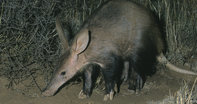
Name
Aardvark (Orycteropus afer)Appearance
Aardvarks have a unique appearance. With a high arched back, long pig-like snout and long pointed ears, these secretive animals are mainly nocturnal and grow to around 110 cm in length.
They are short and stocky, with a shoulder height of around 60 cm and a tail length of around 60 to 70 cm long. Aardvarks are equipped with muscular, short legs covered with long dark fur.
They have strong, powerful nailed claws that are ideal for digging and walking through the bush in South Africa. While their back legs have five digits, their front legs only have four.
Their long snout-like noses are covered in short hairs, perfect for sniffing out prey in the dark. Their tails and ears are long and both taper toward the end.
The aardvark has a unique set of teeth, as they grow only to the back of the jaw and can re-grow simultaneously. Their teeth are not covered in enamel like most animals, but instead are covered in a unique cement-like substance.
Aardvark Diet
The aardvark is an insectivore. It uses its long snout to sniff out termite hills and moves in a zigzag pattern to find its prey. Using its powerful claws, it can easily tear down termite hills and start feeding.
Using its long projectile-like tongue, which is covered in a thick adhesive saliva, it can trap many insects for ingestion at a time. As a result, the Aardvarks teeth have evolved to flat, grinding structures to crush the hard shells of various insects. Aardvarks are also fond of melons.
Aardvark Breeding
Aardvarks have no specific mating season and they only produce 1 offspring at a time. Baby aardvarks are pink and hairless at birth. They are weaned for a period of 7 months and reach maturity at around 2 years old. For the first two weeks of their lives they stay within the burrow, then they accompany their mothers above ground.Aardvark Behaviour
The aardvark is mainly a solitary and quiet animal. It is nocturnal and does all its hunting and burrowing at night. Occasionally, they sunbathe outside their burrows during the day. Aardvarks dig burrows up to 13 cm long and have numerous little tunnels branching off the main one.
Aardvarks burrows for shelter, food, protection and raising their offspring. The aardvarks long ears make for excellent hearing in the dark, however, they have poor eyesight. When threatened, the aardvark makes grunting and bleating sounds. They are also excellent swimmers.
 This bronze piece illustrates a solitary mother’s protective instincts as she prepares her offspring for a life of digging....
This bronze piece illustrates a solitary mother’s protective instincts as she prepares her offspring for a life of digging.... Broad habitat tolerance - open woodland or grassland, also in rain forest in central Africa and in arid zones. Needs sufficient termites for...
Broad habitat tolerance - open woodland or grassland, also in rain forest in central Africa and in arid zones. Needs sufficient termites for... Aardvarks feed mainly on ants in the dry season, while termites are mostly inactive, and feed on termites during the wet season when termite...
Aardvarks feed mainly on ants in the dry season, while termites are mostly inactive, and feed on termites during the wet season when termite... The aardvark is unmistakable by its strange shape. It is an ant and termite specialist and is superbly adapted for this....
The aardvark is unmistakable by its strange shape. It is an ant and termite specialist and is superbly adapted for this....